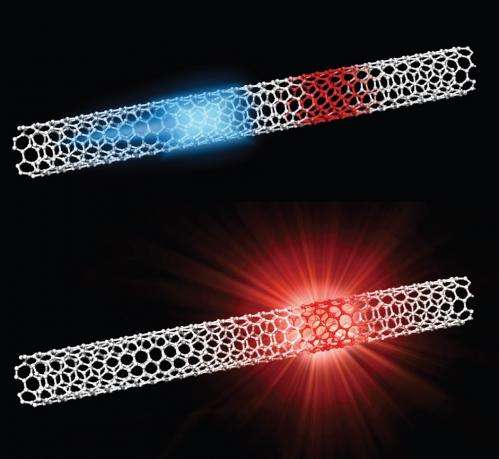July 23, 2013 feature
Light-emitting nanotubes get brighter with zero-dimensional states

Carbon nanotubes have the potential to function as light-emitting devices, which could lead to a variety of nanophotonics applications. However, nanotubes currently have a low luminescence quantum yield, typically around 1%, which is restricted by their one-dimensional nature. In a new study, scientists have demonstrated that artificially modifying the dimensionality of carbon nanotubes by doping them with zero-dimensional states can increase their luminosity to 18%. The findings could lead to the development of nanophotonics devices such as a near-infrared single-photon emitter that operates at room temperature.
The researchers, Yuhei Miyauchi, et al., have published their paper on modifying the dimensionality of carbon nanotubes in a recent issue of Nature Photonics.
Under an applied electric current or light irradiation, excited electrons and holes (positively charged locations where electrons are missing) are created, and carbon nanotubes emit near-infrared light. In this process, excited electrons and holes form bound states called excitons, and a photon is emitted due to the recombination of an electron and a hole during this process.
As the researchers explain, a nanotube's brightness, or luminescence quantum yield, is determined by the balance between the radiative and non-radiative decay rates of its excitons. In nanotubes, non-radiative decay dominates, resulting in low luminescence. Previous research has shown that this non-radiative decay is mainly due to the rapid collision between excitons and nanotube defects, which quench, or suppress, the excitons. Efforts have been made to reduce the defect quenching of the excitons, with varying success.
However, not all defects quench excitons. As the scientists explain, defects with certain electronic structures can capture excitons and convert them into photons with a very high radiative decay rate, possibly even higher than the excitons' intrinsic rate. These beneficial defects function as zero-dimensional states, and the scientists saw them as an opportunity to improve nanotube luminescence.
In experiments, the researchers sparsely doped the carbon nanotubes with oxygen atoms, which act as zero-dimension-like states embedded in the one-dimensional nanotubes. They found that, at room temperature, excitons in the zero-dimension-like states can achieve a luminescence quantum yield of 18%, an order of magnitude larger than the 1% value of those in one-dimensional nanotubes. The researchers attribute this improvement to mechanisms that reduce the non-radiative decay rate and enhance the radiative decay rate, and predict that the luminescence could be further improved.
"We think that the luminescence can be further increased if we can find a better local atomic structure of an artificial zero-dimensional state," Miyauchi, a researcher at Kyoto University and the Japan Science and Technology Agency, told Phys.org. "At this point, our zero-dimensional state has a lower lying dark state just below the bright state, which results in about 50% reduction of the quantum yield at room temperature. If one can find a better local structure, we expect that it may be possible to remove this dark state below the bright state. Then, we expect further increase of the luminescence yield of excitons in the local state."
In the future, the researchers hope that the results will stimulate further investigation of zero-dimensional—one-dimensional hybrid systems, regarding applications as well as the fundamental physics behind the systems.
"We plan to develop a more sophisticated technique to generate only one zero-dimensional state in a single suspended carbon nanotube connected to electrodes, which is necessary to develop a real near-infrared single-photon emitter operable at room temperature using carbon nanotubes," Miyauchi said. "We also plan to try to achieve lasing using this material. Although it has been considered to be very difficult to achieve lasing using carbon nanotubes as gain media because of the very rapid non-radiative decay due to rapid collisions between excitons under a strong excitation regime, we believe that it would be possible using zero-dimensional states in carbon nanotubes, because excitons in zero-dimensional states would avoid collision with other excitons.
"Our findings could also lead to the fabrication of all-carbon near-infrared LEDs or lasers. Near-infrared light sources are very important for telecommunications using optical fibers. One usually needs minor metals such as In, Ga, and As, to fabricate light emitters for this wavelength range. If one can make efficient light sources using only abundant carbon and without any minor metals, it would be very nice from the viewpoint of the resource problem.
"We are also very interested in the fundamental physics in these nice hybrid low-dimensional nanostructures, and we will explore another more interesting physics in them that possibly emerges from the interactions between the states with different dimensions in the same nanostructures."
More information: Yuhei Miyauchi, et al. "Brightening of excitons in carbon nanotubes on dimensionality modification." Nature Photonics. DOI: 10.1038/NPHOTON.2013.179
Journal information: Nature Photonics
© 2013 Phys.org. All rights reserved.





















